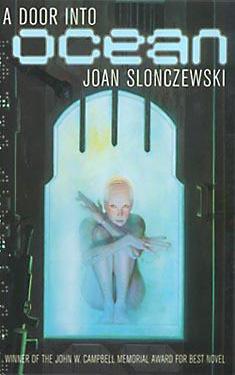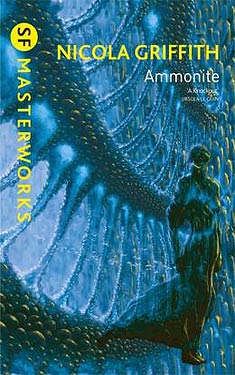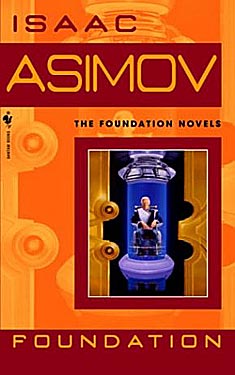 Lamat is the mountain climber. She is of the Holoh people who live in the
shadow of the mountain. She wrote a best-selling
book about an ill-fated climb with her husband and two friends. She is approached by Mother Disaine, an
apostate priest of the Arit sect to guide her up the mountain. Like all priests she is a scientist and knows
some magic. She has used her knowledge
and skill to create a climbing suit to keep the air pressure on the body high
as you climb in elevation. They go up
once, as a test and conditioning run and find the suit has flaws. They get some money from Lamat’s ex-husband
and work to prepare for another suit and another climb. In the meantime, Lamat is ex-communicated
from the Holoh people for her trip up the mountain which seemed to cause a landslide
below, an act of God showing displeasure in Lamat’s latest attempt to scale the
mountain. They go up again and Disaine
returns to claim that she made it to the top.
This book is Lamat’s attempt at a second book, intended only for her partner,
Otile, a real tell-all to describe what really happened on the two trips with
Disaine as well as what really happened with her friends.
Lamat is the mountain climber. She is of the Holoh people who live in the
shadow of the mountain. She wrote a best-selling
book about an ill-fated climb with her husband and two friends. She is approached by Mother Disaine, an
apostate priest of the Arit sect to guide her up the mountain. Like all priests she is a scientist and knows
some magic. She has used her knowledge
and skill to create a climbing suit to keep the air pressure on the body high
as you climb in elevation. They go up
once, as a test and conditioning run and find the suit has flaws. They get some money from Lamat’s ex-husband
and work to prepare for another suit and another climb. In the meantime, Lamat is ex-communicated
from the Holoh people for her trip up the mountain which seemed to cause a landslide
below, an act of God showing displeasure in Lamat’s latest attempt to scale the
mountain. They go up again and Disaine
returns to claim that she made it to the top.
This book is Lamat’s attempt at a second book, intended only for her partner,
Otile, a real tell-all to describe what really happened on the two trips with
Disaine as well as what really happened with her friends.Sunday, August 30, 2020
The Breath of the Sun
 Lamat is the mountain climber. She is of the Holoh people who live in the
shadow of the mountain. She wrote a best-selling
book about an ill-fated climb with her husband and two friends. She is approached by Mother Disaine, an
apostate priest of the Arit sect to guide her up the mountain. Like all priests she is a scientist and knows
some magic. She has used her knowledge
and skill to create a climbing suit to keep the air pressure on the body high
as you climb in elevation. They go up
once, as a test and conditioning run and find the suit has flaws. They get some money from Lamat’s ex-husband
and work to prepare for another suit and another climb. In the meantime, Lamat is ex-communicated
from the Holoh people for her trip up the mountain which seemed to cause a landslide
below, an act of God showing displeasure in Lamat’s latest attempt to scale the
mountain. They go up again and Disaine
returns to claim that she made it to the top.
This book is Lamat’s attempt at a second book, intended only for her partner,
Otile, a real tell-all to describe what really happened on the two trips with
Disaine as well as what really happened with her friends.
Lamat is the mountain climber. She is of the Holoh people who live in the
shadow of the mountain. She wrote a best-selling
book about an ill-fated climb with her husband and two friends. She is approached by Mother Disaine, an
apostate priest of the Arit sect to guide her up the mountain. Like all priests she is a scientist and knows
some magic. She has used her knowledge
and skill to create a climbing suit to keep the air pressure on the body high
as you climb in elevation. They go up
once, as a test and conditioning run and find the suit has flaws. They get some money from Lamat’s ex-husband
and work to prepare for another suit and another climb. In the meantime, Lamat is ex-communicated
from the Holoh people for her trip up the mountain which seemed to cause a landslide
below, an act of God showing displeasure in Lamat’s latest attempt to scale the
mountain. They go up again and Disaine
returns to claim that she made it to the top.
This book is Lamat’s attempt at a second book, intended only for her partner,
Otile, a real tell-all to describe what really happened on the two trips with
Disaine as well as what really happened with her friends.Thursday, August 27, 2020
Izzy and Eve
Monday, August 24, 2020
The Deep
Sunday, August 23, 2020
A Door Into Ocean
 Spinel is a stone-cutter’s
son. He lives on Valedon, a planet in
the same system as Shora. (I wasn’t
quite clear on this, but Shora may be its moon). He’s directionless, not having had much
motivation to find a career for himself.
One day, he comes across two naked purple women from Shora who’ve come
to learn about Valedon. They’ve created
an uproar in the town, but have not met with much resistance. He becomes entranced with them and they offer
to take him back with them to Shora. At
first, he’s excited, but when they actually make a deal with his parents to
take him with them, he balks. Still, he
ends up going. On Shora, he has a tough
time integrating with women there, known as Sharers, but eventually becomes a
part of their culture. The Sharers are
not without their turmoil. They have
foreign traders living on the planet.
Then the invasion comes and they choose to fight the only way they know
how, by passive resistance.
Spinel is a stone-cutter’s
son. He lives on Valedon, a planet in
the same system as Shora. (I wasn’t
quite clear on this, but Shora may be its moon). He’s directionless, not having had much
motivation to find a career for himself.
One day, he comes across two naked purple women from Shora who’ve come
to learn about Valedon. They’ve created
an uproar in the town, but have not met with much resistance. He becomes entranced with them and they offer
to take him back with them to Shora. At
first, he’s excited, but when they actually make a deal with his parents to
take him with them, he balks. Still, he
ends up going. On Shora, he has a tough
time integrating with women there, known as Sharers, but eventually becomes a
part of their culture. The Sharers are
not without their turmoil. They have
foreign traders living on the planet.
Then the invasion comes and they choose to fight the only way they know
how, by passive resistance. Tuesday, August 18, 2020
The Drowning Girl
 India Morgan Phelps, known simply
as Imp, is a dangerously trusting person.
When a neighbor is kicked out of her living situation, she invites her to
stay with her. They quickly fall in
love. Soon after Abalyn moves in, Imp
finds a young woman standing naked on the road in the dark. Out of concern for her, she brings her home,
much to Abalyn’s consternation. Eva
Canning, the young woman, leaves the next day, but Imp becomes obsessed with
her. She see’s her around town. She dreams of her. She begins to see and hear her when no one else
can. Then she goes off her meds. Abalyn can’t handle this and moves out. Is Eva real, a ghost, a siren, a mermaid, a
wolf, or simply a symptom of Imp’s schizophrenia? That is the question that underlies the
novel.
India Morgan Phelps, known simply
as Imp, is a dangerously trusting person.
When a neighbor is kicked out of her living situation, she invites her to
stay with her. They quickly fall in
love. Soon after Abalyn moves in, Imp
finds a young woman standing naked on the road in the dark. Out of concern for her, she brings her home,
much to Abalyn’s consternation. Eva
Canning, the young woman, leaves the next day, but Imp becomes obsessed with
her. She see’s her around town. She dreams of her. She begins to see and hear her when no one else
can. Then she goes off her meds. Abalyn can’t handle this and moves out. Is Eva real, a ghost, a siren, a mermaid, a
wolf, or simply a symptom of Imp’s schizophrenia? That is the question that underlies the
novel. Friday, August 14, 2020
Ring of Swords
 Anna Perez is a researcher of
intelligence in other species. The story
begins where she is working on another planet studying a species of jellyfish-like
creatures that communicate with flashes of light. A group of aliens called the Hwarhath come to
the planet to work out a peace treaty with humans. Their translator is Nicholas Sanders, an
earthling who was captured by the Hwarhath, became a turncoat and sided with
them. Anna becomes caught up in the
diplomatic endeavor, eventually being sent to a Hwarhath space station as an observer
for a new treaty after the first one fails.
Over the course of the talks, Anna learns about the society of the Hwarhath
and Nicholas’ tenuous relationship with them.
Anna Perez is a researcher of
intelligence in other species. The story
begins where she is working on another planet studying a species of jellyfish-like
creatures that communicate with flashes of light. A group of aliens called the Hwarhath come to
the planet to work out a peace treaty with humans. Their translator is Nicholas Sanders, an
earthling who was captured by the Hwarhath, became a turncoat and sided with
them. Anna becomes caught up in the
diplomatic endeavor, eventually being sent to a Hwarhath space station as an observer
for a new treaty after the first one fails.
Over the course of the talks, Anna learns about the society of the Hwarhath
and Nicholas’ tenuous relationship with them.
Sunday, August 9, 2020
Ammonite
 Marghe is an anthropologist going
to the planet known as Jeep to study the culture of the women who inhabit it
for a corporation that wants to exploit its natural resources. The women are the remnants of a colony that
was decimated by a virus that killed all the men and many women. The women who survived somehow had children. The problem with going to Jeep is that the
virus is still active. Marghe, however,
is given an experimental vaccine for the virus, a pill she must take
regularly. She goes to Jeep, meets with
the survivors of the corporation’s base, and then sets off to live with some of
the indigenous cultures. On her way, she
is captured by one tribe. She escapes,
lives with another tribe, and discovers the secrets of the virus and people.
Marghe is an anthropologist going
to the planet known as Jeep to study the culture of the women who inhabit it
for a corporation that wants to exploit its natural resources. The women are the remnants of a colony that
was decimated by a virus that killed all the men and many women. The women who survived somehow had children. The problem with going to Jeep is that the
virus is still active. Marghe, however,
is given an experimental vaccine for the virus, a pill she must take
regularly. She goes to Jeep, meets with
the survivors of the corporation’s base, and then sets off to live with some of
the indigenous cultures. On her way, she
is captured by one tribe. She escapes,
lives with another tribe, and discovers the secrets of the virus and people.Wednesday, August 5, 2020
Foundation
Completed 8/5/2020, Reviewed 8/5/2020
3 stars
Sunday, August 2, 2020
Mother of Souls
Heather Rose
Jones
Completed 8/2/2020,
Reviewed 8/2/2020
4 stars
It took me nearly a week to read this book, not because it was long, though it was longer than the first two. It’s because it was so comfortable being in this world that Heather Rose Jones created. This book introduced two new characters, in addition to the four main characters in the previous books, Daughter of Mystery and Mystic Marriage. The book was much more complex with more plotlines, but I really enjoyed almost all of them. The one plotline I didn’t really care for was the one that had to do with some of the politics of the world. The others though were just wonderful. This book won the Gaylactic Spectrum Award in 2017.
In this book, Margerit tries to open an academy for women that teaches the type of magic she does, as well as other academic areas, because the local university barely tolerates women and doesn’t offer them degrees. Antuniet wants to have a child to carry on the family name and inherit her title if she earns it back, but she wants to do it through alchemy, creating a homunculus. Luzie, a new character, composes music that generates the same type of magical energy that Margerit works in. Her dream is to create an opera. Finally, Serafina, a Rome native whose parents came from Ethiopia, comes to Alpennia because she can see the magic more vividly than anyone she knows, but cannot generate the magic herself.
There are a lot of plots, but they go together well. Jones weaves the storylines in and out of each other nearly seamlessly. I felt she did it much more fluidly than she did in the previous book. The main plotline is the one with Luzie and Serafina, and that was the one I was most interested in. When Luzie and Serafina meet, they find they can work together. Serafina can see the energy coming from Luzie’s music, helping Luzie in her composing to create amazing music. Together, they compose enough music to make an opera. This collaboration also comes into play when it is found that sorcery is being used to block the pass though which people enter the country. It’s blocked with snow from a continuous winter, which doesn’t permit the snow to melt, causing a drought in the country. There’s a lot going on, but it all comes together as a pretty magnificent whole.
Serafina and Luzie really shine as the new characters. Jones noted that her inspiration for Serafina was when he posed the question, “Where were the black people in Europe at this time?” It prompted a lot of research on her part and this is the character she created in response to that. Serafina is married to Paolo who tried to teach her how to do the magic that she so vividly sees. Their marriage was based on this more than love, though Paolo expected her to be a good wife. Because of his job, he is in Paris for three years. That’s what prompts Serafina to go to Alpennia in the first place, seeking better council on her visual gift and lack of creative gift. Luzie is a widow with two children who are away at school. She’s kind of Serafina’s opposite. She can create magical music but cannot see the magic she’s created. When the two come together, it’s wondrous. It also eventually leads to a romance that has many difficulties. Like all the romance in this series, I thought it was done well. It takes into consideration both the women’s existing relationship status and the sexual mores of the day. As a reminder, this book takes place in the early 1800s.
I also appreciated the plotline of the development of the Margerit’s academy. It’s not an easy chore, and not all of her choices are the best. But you cheer for her because women and education do not go so easily hand in hand in this day and age.
Though this book has standalone stories, it is dependent on the previous books for the other plots and the development of the existing characters. There are no real cliffhangers, which I appreciate, though some of the plots clearly continue in the fourth book.
I give this book four stars out of five. It’s much better than the second book, but I still like the first book the best. Reading this book, especially so close to the previous ones, felt like cozying in a comfortable chair in a room filled with your favorite lesbian friends. I’ve read a lot of really good lesbian science fiction and fantasy literature over the past four years, as well as some not so good. This series ranks up there as one of my favorites.



